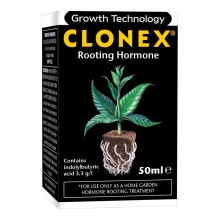- today
- label Plant cultivation
- favorite 6 likes
- remove_red_eye 14651 views
- comment 0 comments

Cuttings, aka Clones: A Fantastic Way to Propagate Plants. How to Do It Right?
Dreaming of adding new potted plant specimens to your collection? If so, mastering the skill of propagating cuttings, also known as "clones" or "cuttings," will be handy. This article thoroughly describes the process of rooting plants in water and moss. With our tips, you'll soon enjoy even more greenery at home.
Cuttings, Also Known as Clones – What Are They? Cuttings, also referred to as "cuttings" or "clones," are unrooted plant segments that are cut off to reproduce the parent plant, aiming to produce offspring identical to it. This method can be used, for example, to root species that are difficult to root by themselves. Moreover, it allows for the propagation of coniferous, deciduous, evergreen, and heath plants. How should it be done correctly?
Rooting Clones in Water There are many ways to root cuttings. One of the most popular methods is using a glass container – it could be a jar, vase, wine glass, mug, etc.
Here's a list of items you might need:
- Glass container
- Scissors (or a knife or scalpel)
- Pot
- Rooting hormone (e.g., Clonex Gel or Hesi ClonFix)
How to Root Cuttings in Water? Below is a guide to rooting cuttings in water.
Pour water into a glass container. It must be either settled or filtered to be free from contaminants. It's also important that it's not too cold and maintained at room temperature. The container itself should be clean and sterilized. Osmotic water can be used.
Cut a shoot segment about 10-15 cm long – especially parts from the middle of the plant are useful, but you can also use shoot tips. Use a sharp tool, such as scissors, a knife, or a scalpel, for cutting. However, make sure not to use pruning shears, which can crush the plant's tissues. Also, ensure you're cutting a healthy plant – it shouldn't be weakened, sick, or infested with parasites. Has it been treated in the last 3-4 months? If so, wait until it fully recovers.
Trim a few lower leaves to avoid contact with water, and if necessary, the upper ones as well.
Immerse the cuttings to a depth of 2-3 cm – the top must stick out, and the bottom should be submerged. To place them at this level, you can use cardboard with holes cut out and then insert the cuttings into them.
Ensure the right conditions – it should always be warm and moist; clones like to root in high temperatures and high humidity. Various kinds of greenhouses and rooting propagators work great here. Avoid placing cuttings on a windowsill, especially in autumn and winter.
Regularly change the water in the container so it doesn't evaporate. This is particularly important when new roots grow from the clone – there must be enough water in the container so they don't dry out. Note that you should replace the water, not just top it up. Such practices help minimize the risk of the cutting rotting and the development of bacteria. Additionally, you can add a bit of rooting hormone to the container, e.g., clonex or another rooting agent.
Rooting cuttings in water usually takes several days to a couple of weeks. You can easily recognize when the process is complete by well-developed roots, which typically appear after 2-3 weeks.
Next, plant the plants in suitable pots and sowing soil. Do this when the roots are at least 3 cm long – this will make it easier for the plants to adapt to new conditions. Pay attention to the size of the pots, so they're not too large. Previously, you should also place nutritious, permeable, and light soil inside.
How to Speed Up Rooting Plants in Water? The simplest way is to use ready-made solutions:
- Rooting tray
- Clonex Gel
- Scalpel
There are methods to get roots much faster. One such method is using a rooting hormone, e.g., Clonex. Such preparations have a wide range of fans. And no wonder, as they not only support, accelerate, and facilitate the entire process but also improve the vitality of cuttings. A significant advantage of many such agents is also their ease of application.
Rooting in water works best for herbaceous cuttings, i.e., green and non-woody stems of potted plants, such as ivy, pothos, or English pelargonium.
What Else to Keep in Mind When Rooting Cuttings in Water? Check out what else you should remember when rooting cuttings in water.
Protecting the Mother Plant
Immediately apply cinnamon to the area where you cut the stem. Why? Because it absorbs the leaking sap from the plant. Cinnamon causes the cut site to dry out and simultaneously protects it from fungal diseases.
Dusting the Leaves
It's beneficial to dust the leaves of both the cutting and the mother plant. This way, their surface can better absorb sunlight.
Prompt Response to Changes
It's crucial to continuously monitor your cutting. If you notice it drying out or yellowing, and the water spoiling, you must immediately find the cause of the problem, as that's the only way to save the cutting. Is your cutting starting to rot? In such cases, cut off the rotten part and apply a fungicidal agent. Products that allow soaking your cutting work especially well in this scenario. After performing this action, it's best to place the plant (after 24 hours) in a clean, sterilized container.
Adding Activated Charcoal
To better care for your clone, it's worth adding activated charcoal to the water. Why? Because it minimizes the risk of fungus and stem rot. Make sure to check when buying charcoal that it's a medicine, not a dietary supplement.
Rooting Cuttings with Moss
Don't have much space for glass containers at home? Or perhaps you're looking for an even faster way to propagate plants? If so, you'll like rooting cuttings using sphagnum moss. How should it be done? Find the answer below.
Sphagnum moss, also known as sphagnum, absorbs a lot of water, which it then releases to the plants. It's also airy and ensures good air circulation; there's plenty of oxygen around its roots, leading to quick rooting of the plant. Cuttings don't suffocate in it, and moreover, it has antibacterial properties, significantly preventing the problem of rotting.
For rooting plants this way, you'll need:
- Moss
- Container.
How to Root Cuttings in Moss? Before starting the rooting process, purchase the right moss. It's available in loose and compressed forms in stores – both variants work well here. However, prefer buying orchid-growing moss rather than terrarium moss found in pet shops.
Choosing the right container is also crucial. Ordinary, plastic cups, in which the root development process is clearly visible, will do the job.
Make small holes at the bottom of the cup, or you can also make them on the sides. This helps get rid of excess water and ensures better air access.
Soak the moss. Pour loose moss into water maintained at room temperature and wait until it's fully saturated. If you have compressed moss, tear off a piece. The packaging should inform how many liters of moss will result from soaking it. Based on the manufacturer's data, tear off as much as you need.
Remove the excess water from the moss – it should be moist, not wet. Place it at the bottom of the cup. Don't compact it; there should be air circulation inside.
Wrap the cutting you plan to root in moss. Try to immobilize it.
Provide the plant with appropriate conditions for development and place it in a location with elevated humidity. For example, you can place the container in a greenhouse, propagator, or under a glass cloche. Don't have anything like that? Buy a zip-lock bag and seal the cup inside – this way, you create something akin to a mini-greenhouse.
Remember, the location where you keep such a cutting should be warm. For instance, you can place it near a radiator (but not on it); heating mats and cables also work well here. If the temperature is too low, there's a risk of the moss molding and the cutting rotting. Moreover, it hinders the root development process.
Regularly check the cutting and its condition every 2-3 days, and also gently air it (e.g., by opening the zip-lock bag). You'll quickly notice that water sometimes evaporates from the container, so for small cups, you should delicately mist the plant, while in larger containers, you might occasionally need to add some water so all the moss is saturated and accessible to all roots of the cutting.
Noticed roots? If so, you can place the plant in the optimal soil for it.
How to Accelerate Rooting in Moss? Adding a rooting hormone to the moss is really time-efficient, and you'll notice the results much faster. If you keep the plant in ideal conditions, i.e., humidity at 80-90%, at a temperature of 28°C, and additionally spray it with a rooting stimulator, the first roots can appear within 3 days.
What Else to Keep in Mind When Rooting Cuttings in Water? It's important that the moss used in the rooting process can be reused multiple times. Also, remember that moss fibers can sometimes resemble roots, and vice versa. So, be careful not to break a root.






Comments (0)